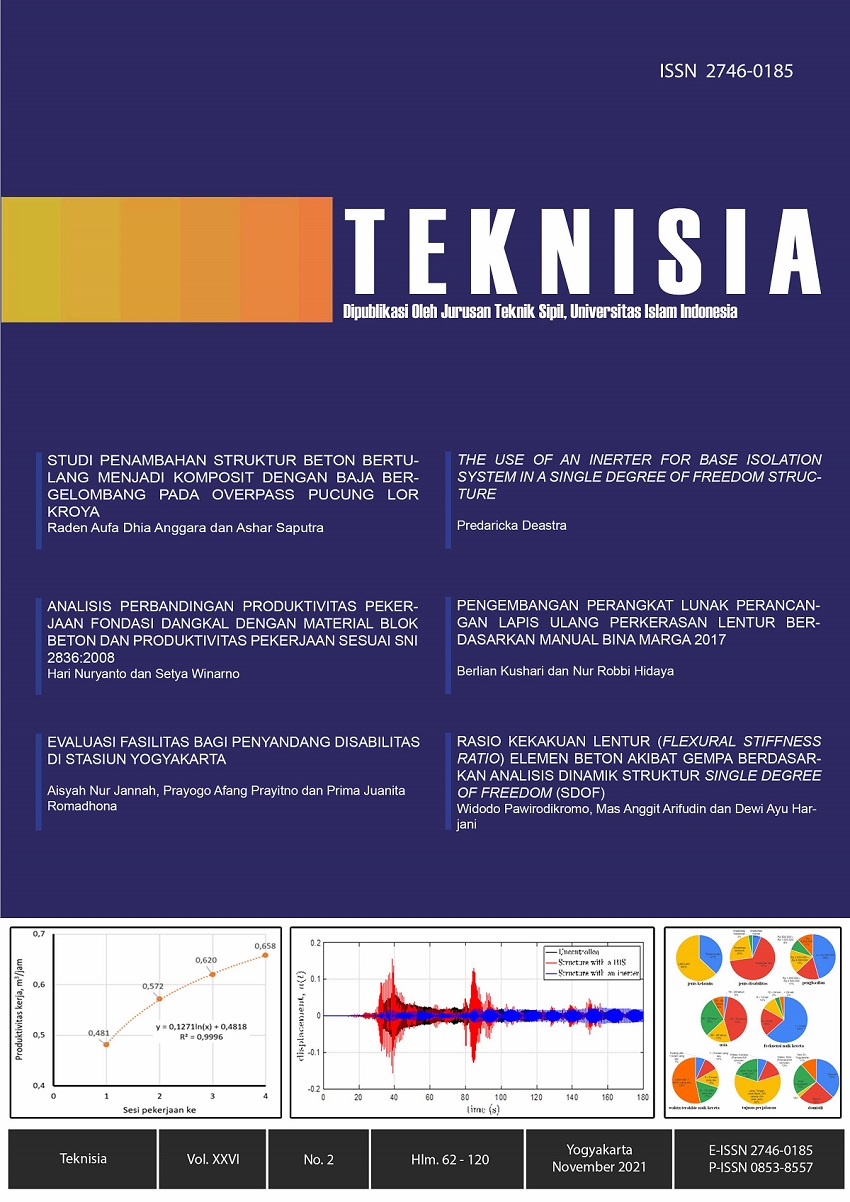Main Article Content
Abstract
Keywords
Article Details
Under the following term:
-
Attribution — You must give appropriate credit, provide a link to the license, and indicate if changes were made. You may do so in any reasonable manner, but not in any way that suggests the licensor endorses you or your use.
-
ShareAlike — If you remix, transform, or build upon the material, you must distribute your contributions under the same license as the original.
- No additional restrictions — You may not apply legal terms or technological measures that legally restrict others from doing anything the license permits.
References
- J. M. Kelly, Earthquake-resistant design with rubber, Vol. 7, 1993.
- W. H. Robinson, Lead-rubber hysteretic bearings suitable for protecting structures during earthquakes, Earthquake Engineering & Structural Dynamics, vol. 10, no. 4, pp. 593-604, 1982.
- A. Mokha, M. Constantinou, A. Reinhorn, and V. A. Zayas, Experimental study of friction-pendulum isolation system, Journal of Structural Engineering, vol. 117, no. 4, pp. 1201-1217, 1991.
- Y.-P.Wang, M.-C. Teng, and K.-W. Chung, Seismic isolation of rigid cylindrical tanks using friction pendulum bearings, Earthquake engineering & structural dynamics, vol. 30, no. 7, pp. 1083-1099, 2001.
- G. C. Lee, Y.-C. Ou, T. Niu, J. Song, and Z. Liang, Characterization of a roller seismic isolation bearing with supplemental energy dissipation for highway bridges, Journal of Structural Engineering, vol. 136, no. 5, pp. 502-510, 2010.
- N. A. Ortiz, C. Magluta, and N. Roitman, Numerical and experimental studies of a building with roller seismic isolation bearings, Structural Engineering and Mechanics, vol. 54, no. 3, pp. 475-489, 2015.
- M. C. Smith, Synthesis of mechanical networks: The inerter, IEEE Transactions on Automatic Control, vol. 47, no. 10, pp. 1648-1662, 2002.
- Deastra, Predaricka, D. J. Wagg, and N. D. Sims. The effect of a tuned-inerter-damper on the seismic response of base-isolated structures. 16th European Conference on Earthquake Engineering, Thessaloniki, 2018.
- Soong, Ming Foong, Rahizar Ramli, and Wan Nor Liza Wan Mahadi. Vehicle suspensions with parallel inerter: Effectiveness in improving vibration isolation. Journal of Vibroengineering 16.1 (2014): 256-265.
- Dong, Xin, Yuane Liu, and Michael ZQ Chen. Application of inerter to aircraft landing gear suspension. 34th Chinese Control Conference (CCC). IEEE, 2015.
- Papageorgiou, C., Houghton, N.E., Smith, M.C., Experimental testing and analysis of inerter devices. J. Dyn. Syst. Meas. Contr. 131(1), 011001. 2009.
- I. Lazar, S. Neild, and D. Wagg, Using an inerter-based device for structural vibration suppression, Earthquake Engineering & Structural Dynamics, vol. 43, no. 8, pp. 1129-1147, 2014.
- Marian, Laurentiu, and Agathoklis Giaralis. Optimal design of a novel tuned mass-damper–inerter (TMDI) passive vibration control configuration for stochastically support-excited structural systems. Probabilistic Engineering Mechanics 38 (2014): 156-164.
- Chen, Michael ZQ, et al. Influence of inerter on natural frequencies of vibration systems. Journal of Sound and Vibration 333.7 (2014): 1874-1887.
- Deastra, P., D. J. Wagg, and N. D. Sims. Using a Tuned-Inerto-Viscous-Hysteretic-Damper (TIVhD) for vibration suppression in multi-storey building structures. IOP Conference Series: Earth and Environmental Science. Vol. 708. No. 1. IOP Publishing, 2021.
References
J. M. Kelly, Earthquake-resistant design with rubber, Vol. 7, 1993.
W. H. Robinson, Lead-rubber hysteretic bearings suitable for protecting structures during earthquakes, Earthquake Engineering & Structural Dynamics, vol. 10, no. 4, pp. 593-604, 1982.
A. Mokha, M. Constantinou, A. Reinhorn, and V. A. Zayas, Experimental study of friction-pendulum isolation system, Journal of Structural Engineering, vol. 117, no. 4, pp. 1201-1217, 1991.
Y.-P.Wang, M.-C. Teng, and K.-W. Chung, Seismic isolation of rigid cylindrical tanks using friction pendulum bearings, Earthquake engineering & structural dynamics, vol. 30, no. 7, pp. 1083-1099, 2001.
G. C. Lee, Y.-C. Ou, T. Niu, J. Song, and Z. Liang, Characterization of a roller seismic isolation bearing with supplemental energy dissipation for highway bridges, Journal of Structural Engineering, vol. 136, no. 5, pp. 502-510, 2010.
N. A. Ortiz, C. Magluta, and N. Roitman, Numerical and experimental studies of a building with roller seismic isolation bearings, Structural Engineering and Mechanics, vol. 54, no. 3, pp. 475-489, 2015.
M. C. Smith, Synthesis of mechanical networks: The inerter, IEEE Transactions on Automatic Control, vol. 47, no. 10, pp. 1648-1662, 2002.
Deastra, Predaricka, D. J. Wagg, and N. D. Sims. The effect of a tuned-inerter-damper on the seismic response of base-isolated structures. 16th European Conference on Earthquake Engineering, Thessaloniki, 2018.
Soong, Ming Foong, Rahizar Ramli, and Wan Nor Liza Wan Mahadi. Vehicle suspensions with parallel inerter: Effectiveness in improving vibration isolation. Journal of Vibroengineering 16.1 (2014): 256-265.
Dong, Xin, Yuane Liu, and Michael ZQ Chen. Application of inerter to aircraft landing gear suspension. 34th Chinese Control Conference (CCC). IEEE, 2015.
Papageorgiou, C., Houghton, N.E., Smith, M.C., Experimental testing and analysis of inerter devices. J. Dyn. Syst. Meas. Contr. 131(1), 011001. 2009.
I. Lazar, S. Neild, and D. Wagg, Using an inerter-based device for structural vibration suppression, Earthquake Engineering & Structural Dynamics, vol. 43, no. 8, pp. 1129-1147, 2014.
Marian, Laurentiu, and Agathoklis Giaralis. Optimal design of a novel tuned mass-damper–inerter (TMDI) passive vibration control configuration for stochastically support-excited structural systems. Probabilistic Engineering Mechanics 38 (2014): 156-164.
Chen, Michael ZQ, et al. Influence of inerter on natural frequencies of vibration systems. Journal of Sound and Vibration 333.7 (2014): 1874-1887.
Deastra, P., D. J. Wagg, and N. D. Sims. Using a Tuned-Inerto-Viscous-Hysteretic-Damper (TIVhD) for vibration suppression in multi-storey building structures. IOP Conference Series: Earth and Environmental Science. Vol. 708. No. 1. IOP Publishing, 2021.
